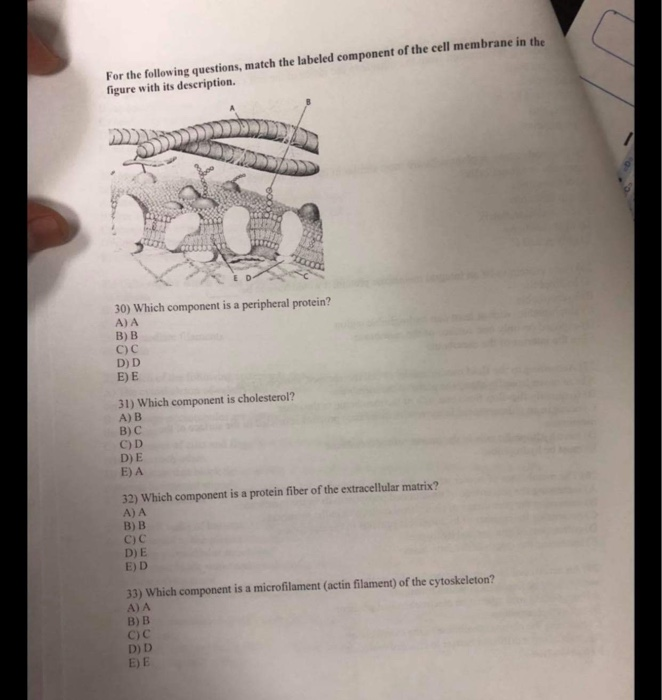Cell membrane. Specialized structure that surrounds the cell and its internal environment; controls movement of substances into/out of cell. Hydrophobic. Molecule that repels water (“water-fearing”) Hydrophilic. Molecule that is attracted to water (“water-loving”) Amphipathic. Molecule that contains both a hydrophobic and a hydrophilic end.
Solved Match the description with the correct component of a | Chegg.com
Step 1 A bilayer of lipids that is flexible and consists of the cytoplasm… View the full answer Step 2 Final answer Previous question Next question Transcribed image text: Matching Match each membrane component with the correct description of structure or function.

Source Image: chegg.com
Download Image
Question: Match the descriptions with the correct membrane component Only spans one leaflet of the membrane Protein Phospholipid Can span both leaflets of a membrane Can anchor to the cytoskeleton inside the cell Small and amphipathic Can be attached to the surface of a membrane Show transcribed image text There are 2 steps to solve this one.
Source Image: madebyteachers.com
Download Image
Solved Match the description with the correct component of a | Chegg.com In eukaryotic cells, the plasma membrane surrounds a cytoplasm filled with ribosomes and organelles. Organelles are structures that are themselves encased in membranes. Some organelles (nuclei, mitochondria, chloroplasts) are even surrounded by double membranes. All cellular membranes are composed of two layers of phospholipids embedded with

Source Image: elandlodge.com
Download Image
Match The Descriptions With The Correct Membrane Component.
In eukaryotic cells, the plasma membrane surrounds a cytoplasm filled with ribosomes and organelles. Organelles are structures that are themselves encased in membranes. Some organelles (nuclei, mitochondria, chloroplasts) are even surrounded by double membranes. All cellular membranes are composed of two layers of phospholipids embedded with The principal components of a plasma membrane are lipids (phospholipids and cholesterol), proteins, and carbohydrates attached to some of the lipids and some of the proteins. A phospholipid is a molecule consisting of glycerol, two fatty acids, and a phosphate-linked head group.
Ariat Mens Moresby H20 Boots – Eland Lodge
The principal components of the plasma membrane are lipids (phospholipids and cholesterol), proteins, and carbohydrate groups that are attached to some of the lipids and proteins. A phospholipid is a lipid made of glycerol, two fatty acid tails, and a phosphate-linked head group. Merlyn Ionic Wet Room Shower Screen Panel With Wall Brackets – 760mm

Source Image: wetrooms-online.com
Download Image
Solved Match the description with its corresponding | Chegg.com The principal components of the plasma membrane are lipids (phospholipids and cholesterol), proteins, and carbohydrate groups that are attached to some of the lipids and proteins. A phospholipid is a lipid made of glycerol, two fatty acid tails, and a phosphate-linked head group.

Source Image: chegg.com
Download Image
Solved Match the description with the correct component of a | Chegg.com Cell membrane. Specialized structure that surrounds the cell and its internal environment; controls movement of substances into/out of cell. Hydrophobic. Molecule that repels water (“water-fearing”) Hydrophilic. Molecule that is attracted to water (“water-loving”) Amphipathic. Molecule that contains both a hydrophobic and a hydrophilic end.

Source Image: chegg.com
Download Image
Solved Match the description with the correct component of a | Chegg.com Question: Match the descriptions with the correct membrane component Only spans one leaflet of the membrane Protein Phospholipid Can span both leaflets of a membrane Can anchor to the cytoskeleton inside the cell Small and amphipathic Can be attached to the surface of a membrane Show transcribed image text There are 2 steps to solve this one.

Source Image: chegg.com
Download Image
Solved For the following questions, match the labeled | Chegg.com A cell’s plasma membrane defines the boundary of the cell and determines the nature of its contact with the environment. Cells exclude some substances, take in others, and excrete still others, all in controlled quantities. Plasma membranes enclose the borders of cells, but rather than being a static bag, they are dynamic and constantly in flux.

Source Image: chegg.com
Download Image
SOLVED: ‘2. Match: Read about each organelle. Then match each organelle to its function/description. Capsule Nucleoid Plasmid A. Hair-like structure that the cell uses for movement. B. Hair-like structure that attaches the In eukaryotic cells, the plasma membrane surrounds a cytoplasm filled with ribosomes and organelles. Organelles are structures that are themselves encased in membranes. Some organelles (nuclei, mitochondria, chloroplasts) are even surrounded by double membranes. All cellular membranes are composed of two layers of phospholipids embedded with

Source Image: numerade.com
Download Image
Inside the Cell Membrane – YouTube The principal components of a plasma membrane are lipids (phospholipids and cholesterol), proteins, and carbohydrates attached to some of the lipids and some of the proteins. A phospholipid is a molecule consisting of glycerol, two fatty acids, and a phosphate-linked head group.

Source Image: youtube.com
Download Image
Solved Match the description with its corresponding | Chegg.com
Inside the Cell Membrane – YouTube Step 1 A bilayer of lipids that is flexible and consists of the cytoplasm… View the full answer Step 2 Final answer Previous question Next question Transcribed image text: Matching Match each membrane component with the correct description of structure or function.
Solved Match the description with the correct component of a | Chegg.com SOLVED: ‘2. Match: Read about each organelle. Then match each organelle to its function/description. Capsule Nucleoid Plasmid A. Hair-like structure that the cell uses for movement. B. Hair-like structure that attaches the A cell’s plasma membrane defines the boundary of the cell and determines the nature of its contact with the environment. Cells exclude some substances, take in others, and excrete still others, all in controlled quantities. Plasma membranes enclose the borders of cells, but rather than being a static bag, they are dynamic and constantly in flux.